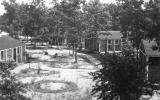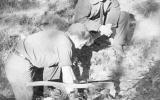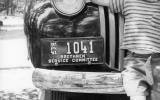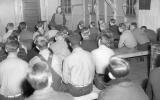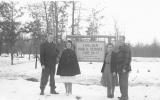CPS Unit Number 017-01
Camp: 17
Unit ID: 1
Title: Stronach
Operating agency: BSC
Opened: 8 1941
Closed: 6 1942
Workers
Total number of workers who worked in this camp: 165
-
 CPS Camp No. 17, Stronach Michigan.Wash house at left; dormitories at right.Digital Image © 2011 Brethren Historical Library and Archives. All Rights Reserved.
CPS Camp No. 17, Stronach Michigan.Wash house at left; dormitories at right.Digital Image © 2011 Brethren Historical Library and Archives. All Rights Reserved. -
 CPS Camp No. 17, Stronach Michigan.Project supervisor George Milnes and act tree planter Harold McKimmy.Digital Image © 2011 Brethren Historical Library and Archives. All Rights Reserved.
CPS Camp No. 17, Stronach Michigan.Project supervisor George Milnes and act tree planter Harold McKimmy.Digital Image © 2011 Brethren Historical Library and Archives. All Rights Reserved. -
 CPS Camp No. 17, Stronach Michigan.License plate, cost 50 cents for truck.Digital Image © 2011 Brethren Historical Library and Archives. All Rights Reserved.
CPS Camp No. 17, Stronach Michigan.License plate, cost 50 cents for truck.Digital Image © 2011 Brethren Historical Library and Archives. All Rights Reserved. -
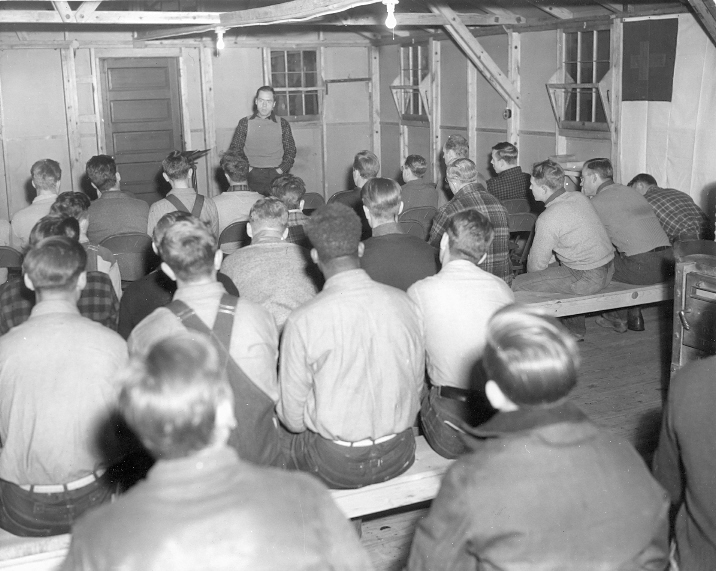 CPS Camp No. 17, Stronach Michigan.General camp meeting.Digital Image © 2011 Brethren Historical Library and Archives. All Rights Reserved.
CPS Camp No. 17, Stronach Michigan.General camp meeting.Digital Image © 2011 Brethren Historical Library and Archives. All Rights Reserved. -
 CPS Camp No. 17, Stronach Michigan.Left to Right: Robert Eshlemen, business manager; Floy Eshleman, dietician and nurse: Mrs. Blickenstaff; Lloyd Blickenstaff, camp director.Digital Image © 2011 Brethren Historical Library and Archives. All Rights Reserved.
CPS Camp No. 17, Stronach Michigan.Left to Right: Robert Eshlemen, business manager; Floy Eshleman, dietician and nurse: Mrs. Blickenstaff; Lloyd Blickenstaff, camp director.Digital Image © 2011 Brethren Historical Library and Archives. All Rights Reserved.
CPS Camp No. 17, a Forest Service base camp located in Stronach, Michigan and operated by the Brethren Service Committee, opened in August 1941 and closed in June 1942. Men fought fires in fire season, and conducted preventive or preparatory work for fire control year round.
Stronach was also known as Camp Manistee and began as CPS No. 1.
Director: Lloyd Blickenstaff
CPS men at Brethren camps tended to report a mix of religious affiliations when entering CPS. About half reported denominational affiliation with Brethren groups.
A number of the men were married and their wives lived in the community.
Men at Brethren camps on average had completed 12.22 years of education when entering CPS. Twelve percent of men in Brethren camps reported their occupation when entering CPS as students; twenty nine percent as farmers or other agricultural workers; eighteen percent as technical or professional work; sixteen percent as business management, sales and public administration; twenty one percent as skilled and semi-skilled trades; and four percent as factory and other work. (Sibley and Jacob pp. 171-72)
Men fought fires in fire season and conducted preventive or preparatory work for fire control. They spent many days building roads and trails into back country, felling dead trees known as “snags”, building and maintaining lookout systems. Men spent many weeks and months replanting logged-out and burned-over areas.
When CPS No. 17 closed in June 1942, it moved to Wellston, Michigan and became CPS No. 42 under the same director.
The CPS program at Stronach in Manistee County faced detractors in the community. Virginia Rohwer, with other wives who worked in Manistee, learned that some in the community were threatening to harm the wives of CPS men at the camp. As a result, she moved to Grand Rapids, where she felt safer. (Goossen p. 64-65)
The Brethren Service Committee envisioned that the leisure hours for men in the camps would provide important opportunities for development. Men could apply their pacifist beliefs in community living as well as in the educational and service programs of camps. Planners worked very hard to develop programs that would respond to the men’s interests, and also contribute to their personal growth and development as creative leaders.
The men began a camp paper called Builders in September 1941 and continued publishing it through March 1942. The paper with the same title was continued when the camp moved to Wellston.
For more information on work in Brethren camps see Leslie Eisan, Pathways of Peace: A History of the Civilian Public Service Program Administered by the Brethren Service Committee. Elgin, IL: Brethren Publishing House, 1948, pp. 74-84; for life in base camps, see pp. 112-187.
For more information on women COs see Rachel Waltner Goossen, Women Against the Good War: Conscientious Objection and Gender on the American Home Front, 1941-47. Chapel Hill, NC: The University of North Carolina Press, 1997.
See also Mulford Q. Sibley and Philip E. Jacob, Conscription of Conscience: The American State and the Conscientious Objector, 1940-1947. Ithaca, NY: Cornell University Press, 1952.
Swarthmore College Peace Collection, Camp periodicals database.
